
Index
Introduction
Origins
1816 to 1863
1863 to 1900
Bibliography
The Rock Island Government Bridge
Railroads in the 1850ísprovided a new way to transport goods in the Upper
Mississippi Valley. Direct transport of goods to and from the East by land rather than by
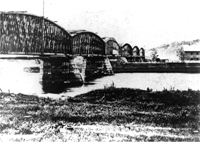 water to St. Louis or New Orleans appeared to be a threat to the steamboat industry.
Because of the steamboat monopoly on transportation of goods, prices were high. When the
first bridge across the Mississippi was built
at Rock Island, Steamboat Packet
companies definitely felt their livelihood
threatened. The bridge was not constructed
in the best manner. Major Floyd of the
Corps of Engineers remarked in his 1856
report,“I look upon that bridge,
as now located and constructed, being situated at the narrowest point on the rapids, where
the current has the greatest velocity, and the piers at an angle to the current, to be a greater
obstruction to the navigation of the Rock Island rapids than all the balance of the rapids
besides” (Tweet).
water to St. Louis or New Orleans appeared to be a threat to the steamboat industry.
Because of the steamboat monopoly on transportation of goods, prices were high. When the
first bridge across the Mississippi was built
at Rock Island, Steamboat Packet
companies definitely felt their livelihood
threatened. The bridge was not constructed
in the best manner. Major Floyd of the
Corps of Engineers remarked in his 1856
report,“I look upon that bridge,
as now located and constructed, being situated at the narrowest point on the rapids, where
the current has the greatest velocity, and the piers at an angle to the current, to be a greater
obstruction to the navigation of the Rock Island rapids than all the balance of the rapids
besides” (Tweet).
On May 6, 1856 the steamboat, Effie Afton, was making a trip north to Minneapolis-
St. Paul and, passing under the bridge, hit one of the pilings. Proceeding a little ways
further the paddlewheel stopped operating and the boat was carried by the current back
downriver, crashing into the bridge. A fire ignited the Effie Afton destroying the boat.
This accident was fuel for the boat owners
to sue the railroad and the bridge company,
which was owned by the railroad. Abraham
Lincoln was hired by the railroad as their defense attorney against the suit. The boat owners didnít win the suit. They appealed the
decision but when it got to the Supreme Court, with the Civil War
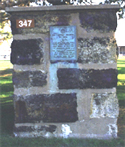 raging and all its inherent
problems, the court did not rule in favor of the boat owners.
raging and all its inherent
problems, the court did not rule in favor of the boat owners.
In 1857, 1,667 boats and rafts passed the Rock Island bridge. Out of that number, 55 collided with the bridge. (Tweet 59) Other boats met their demise near or at the bridge. One which was the Grey Eagle, the fastest boat on the upper Mississippi River, ran into a pier of the Rock Island Bridge and was destroyed on May 9, 1861. In 1865, because of damage to the bridge caused by traffic, ice flows, and wind, the bridge was reinforced with heavier timbers. In the spring of 1868, ice moved a pier and the wind blew the swing span into the river. The government proposed the bridge be moved to its present site. (Slattery 62-68)
Major G. K. Warren of the St. Paul Office of Engineers was placed in a supervisory position overseeing the construction of the new Rock Island bridge in 1869 when the government decided to place the construction job in the hands of the Corps of Engineers rather than Department of Ordnance. The replacement bridge had been designed by Brevet Brigadier General T. J. Rodman, Rock Island Arsenal commandant. Rodmanís design called for “a drawspan with two clear openings, each 160 feet wide, for steamboats, and a span for rafts next to the draw 250 feet wide.” (Tweet 108). Rodmanís plan also called for two levels, the bottom level for railroad and the top level for wagon traffic. (Tweet 108-109)
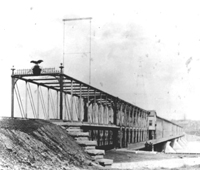 Major Warren did not agree with Rodmanís design. One of Warrenís beliefs was
that railroad bridges should be designed with the well being of steamboats in mind. A report
he made, and published in 1878, on bridge building on western waters emphasized
designing with steamboats in mind.
Seeing that Rodman did not have that
design element, Warren redesigned
Rodmanís plans. The drawspan was
redesigned and relocated next to the
island shore. Warren include two spans
for rafts to allow for differing river
conditions. Then, so sparks, smoke and
noise would not frighten horses, Warren designed the bridge with the railroad on the upper
level and the wagonway on the lower level. Warrenís drawspan was 366 feet long and operated on a pivot. That pivot is still in operation today, though the rest of the bridge has
been redesigned. Because of funding problems, Warren designed the bridge as a single track
operation although the piers were designed and built for double track. Congress felt the cost
of the bridge should be shouldered by the railroad as well as the government, with the
governmentís share not to exceed $1,000,000.00 dollars. The 1,546 foot long bridge was
completed under Colonel John N. Macomb and opened to traffic in November of 1872. The
total construction cost $999,261.00.
(Tweet 109-110)
Major Warren did not agree with Rodmanís design. One of Warrenís beliefs was
that railroad bridges should be designed with the well being of steamboats in mind. A report
he made, and published in 1878, on bridge building on western waters emphasized
designing with steamboats in mind.
Seeing that Rodman did not have that
design element, Warren redesigned
Rodmanís plans. The drawspan was
redesigned and relocated next to the
island shore. Warren include two spans
for rafts to allow for differing river
conditions. Then, so sparks, smoke and
noise would not frighten horses, Warren designed the bridge with the railroad on the upper
level and the wagonway on the lower level. Warrenís drawspan was 366 feet long and operated on a pivot. That pivot is still in operation today, though the rest of the bridge has
been redesigned. Because of funding problems, Warren designed the bridge as a single track
operation although the piers were designed and built for double track. Congress felt the cost
of the bridge should be shouldered by the railroad as well as the government, with the
governmentís share not to exceed $1,000,000.00 dollars. The 1,546 foot long bridge was
completed under Colonel John N. Macomb and opened to traffic in November of 1872. The
total construction cost $999,261.00.
(Tweet 109-110)
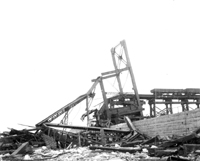 By 1888, with a mule-drawn
streetcar mode of public transportation,
and heavier railroad cars and engines,
along with the need for a double track
for the railroad, the bridge was quickly becoming outdated. In March 1895, Congress
authorized construction to replace the 1872 bridge. The new construction would be on the
same site as the 1872 bridge utilizing that
bridgeís piers and include a double track
for the railroad. Construction began
in November of 1895. So not to interrupt
rail traffic, construction was done section
by section. The construction proceeded
quickly until February of 1896 when an
ice jam caused major damage to the swingspan. Later, that summer, high
water in the Mississippi River slowed
down the project, also. The bridge finally
opened on December 1, 1896.
By 1888, with a mule-drawn
streetcar mode of public transportation,
and heavier railroad cars and engines,
along with the need for a double track
for the railroad, the bridge was quickly becoming outdated. In March 1895, Congress
authorized construction to replace the 1872 bridge. The new construction would be on the
same site as the 1872 bridge utilizing that
bridgeís piers and include a double track
for the railroad. Construction began
in November of 1895. So not to interrupt
rail traffic, construction was done section
by section. The construction proceeded
quickly until February of 1896 when an
ice jam caused major damage to the swingspan. Later, that summer, high
water in the Mississippi River slowed
down the project, also. The bridge finally
opened on December 1, 1896.
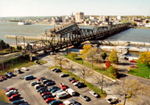 Except for the limestone piers
being covered with a layer of concrete in
the 1920ís, the bridge has remained
essentially the same. Joint ownership was held by the Rock Island Railroad and the
government for 84 years. In 1980, the Rock Island Lines went out of business and the
ownership of the bridge and all its features have been deferred to the government.
(The Target 7)
Except for the limestone piers
being covered with a layer of concrete in
the 1920ís, the bridge has remained
essentially the same. Joint ownership was held by the Rock Island Railroad and the
government for 84 years. In 1980, the Rock Island Lines went out of business and the
ownership of the bridge and all its features have been deferred to the government.
(The Target 7)
to the Top of Page
Home
Web Page Design by
last updated
Joe Nobiling, IM
Clock Tower Building
Rock Island, Illinois 61204-2004
(309) 794-5671
email contact
13 April 2000